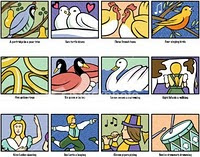Figgy pudding is a pudding is something like a white Christmas pudding containing figs. The pudding may be baked, steamed in the oven, boiled or fried.


The history of figgy pudding dates back to 16th century England.
We know of figgy pudding because of the Christmas carol "We Wish You A Merry Christmas," which sings, "Oh bring us a figgy pudding" in the chorus, suggesting that it was a traditional Christmas dish served during the season and maybe was handed out to Christmas carolers.
Figgy Pudding
1 cup suet (Suet is raw beef (or mutton) fat, especially the fat found around the loins and kidneys)
1 cup sugar
3 large egg yolks
1 cup milk
2 tablespoons rum
1 apple peeled, cored and finely chopped
1 pound dried figs, ground or finely chopped
Grated peel of 1 lemon and 1 orange
1 cup chopped nuts
1/2 teaspoon ground cinnamon
1/4 teaspoon ground cloves
1/4 teaspoon ground ginger
1 1/2 cups dried bread crumbs
2 teaspoons baking powder
3 large egg whites, stiffly beaten
Grease a two-quart mold.
Cream together butter and shortening. Gradually add sugar, egg yolks, milk, extract, apple, figs, lemon and orange peel. Add next 6 ingredients, mixing well. Fold stiffly beaten egg whites into mixture.
Pour into two-quart buttered bowl or mold and place into large shallow pan and steam for four hours.
Custard Sauce
2 cups milk
1 large egg
3/4 cups sugar
1 tablespoon water
1 teaspoon vanilla extract
1 tablespoon flour
1 tablespoon butter
In saucepan, scald milk and allow to cool.
Mix together remaining ingredients, except for butter. Add to cooled milk. Cook over low heat until thickened. Remove from heat and stir in butter, mixing well.
Serve pudding warm with custard sauce or sweetened whipped cream.
Figgy Pudding
1 cup suet (Suet is raw beef (or mutton) fat, especially the fat found around the loins and kidneys)
1 cup sugar
3 large egg yolks
1 cup milk
2 tablespoons rum
1 apple peeled, cored and finely chopped
1 pound dried figs, ground or finely chopped
Grated peel of 1 lemon and 1 orange
1 cup chopped nuts
1/2 teaspoon ground cinnamon
1/4 teaspoon ground cloves
1/4 teaspoon ground ginger
1 1/2 cups dried bread crumbs
2 teaspoons baking powder
3 large egg whites, stiffly beaten
Grease a two-quart mold.
Cream together butter and shortening. Gradually add sugar, egg yolks, milk, extract, apple, figs, lemon and orange peel. Add next 6 ingredients, mixing well. Fold stiffly beaten egg whites into mixture.
Pour into two-quart buttered bowl or mold and place into large shallow pan and steam for four hours.
Custard Sauce
2 cups milk
1 large egg
3/4 cups sugar
1 tablespoon water
1 teaspoon vanilla extract
1 tablespoon flour
1 tablespoon butter
In saucepan, scald milk and allow to cool.
Mix together remaining ingredients, except for butter. Add to cooled milk. Cook over low heat until thickened. Remove from heat and stir in butter, mixing well.
Serve pudding warm with custard sauce or sweetened whipped cream.
 Good King Wenceslas is a popular Christmas carol about a king who goes out to give gifts to a poor peasant on the Feast of Stephen which is the second day of Christmas, December 26.
Good King Wenceslas is a popular Christmas carol about a king who goes out to give gifts to a poor peasant on the Feast of Stephen which is the second day of Christmas, December 26.The song is based on the life of the historical Saint Wenceslaus I, Duke of Bohemia. (907–935)
12 Days of Christmas (song)
It may have been about a woman, whose "True Love", sent her gifts.
Some believe the songs gifts are hidden codes or meanings to the teachings of faith.
There is some disagreement about this however because from 1558 until 1829, Roman Catholics in England were not allowed to practice their Faith openly. At that time (according to those Roman Catholics), this traditional English carol was adopted as a catechism song for young Catholics.
For them, it had two levels of meaning: the original surface meaning as the love song, plus hidden religious meanings.
With the hidden meanings, "true love" you hear about in the song, we are told, refers to God Himself.
The other symbols or codes mean the following:
2 Turtle Doves = The Old and New Testaments
3 French Hens = Faith, Hope and Charity, the Theological Virtues
4 Calling Birds = the Four Gospels and/or the Four Evangelists
5 Golden Rings = The first Five Books of the Old Testament, the "Pentateuch", which gives the history of man's fall from grace.
6 Geese A-laying = the six days of creation
7 Swans A-swimming = the seven gifts of the Holy Spirit, the seven sacraments
8 Maids A-milking = the eight beatitudes
9 Ladies Dancing = the nine Fruits of the Holy Spirit
10 Lords A-leaping = the ten commandments
11 Pipers Piping = the eleven faithful apostles
12 Drummers Drumming = the twelve points of doctrine in the Apostle's Creed
